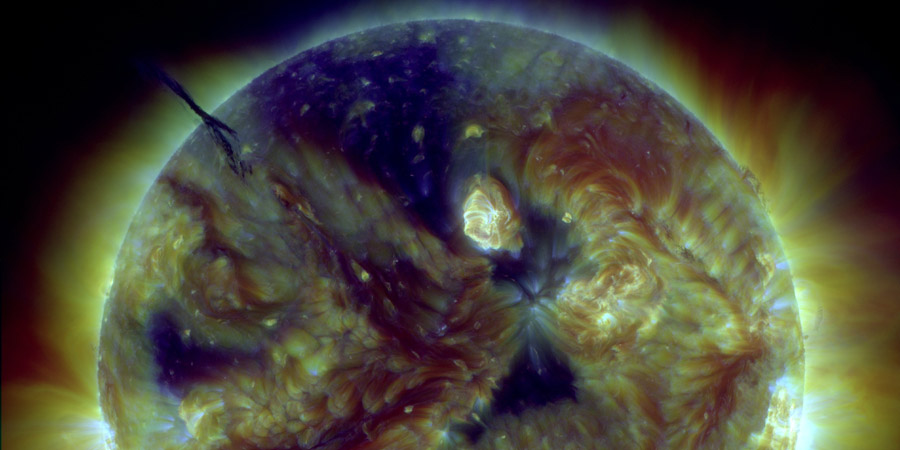Filament eruption, incoming coronal holes
Tuesday, 28 April 2015 18:23 UTC

A large filament channel which was located on the NE quadrant of the Sun has erupted during the past few hours and launched a bright coronal mass ejection into space.
While it is a fantastic event to watch as you can see in the video above from NASA SDO, there will likely be no or only a very minor earth-directed component to this coronal mass ejection. SOHO does show a bright coronal mass ejection leaving the Sun but we need to wait for more SOHO imagery to confirm the exact trajectory of this CME. More information will be provided later if needed.
Coronal holes facing Earth
Solar activity on the other hand remains low with hardly even a C-class solar flare being observed. This is likely to remain so as no sunspot regions on the earth-facing disk right now look to be capable of producing a strong solar flare.
There are however now two coronal holes facing Earth. Solar wind flowing from these coronal hole could arrive in two days for now and cause active geomagnetic conditions (up to Kp4) during the first few days of May.
Thank you for reading this article! Did you have any trouble with the technical terms used in this article? Our help section is the place to be where you can find in-depth articles, a FAQ and a list with common abbreviations. Still puzzled? Just post on our forum where we will help you the best we can!
Current data suggests there is a slight possibility for aurora to appear at the following high latitude regions in the near future
Iqaluit, NUNuuk
Reykjavik
Tromsø
Kiruna
Latest news
Latest forum messages
Support SpaceWeatherLive.com!
A lot of people come to SpaceWeatherLive to follow the Sun's activity or if there is aurora to be seen, but with more traffic comes higher server costs. Consider a donation if you enjoy SpaceWeatherLive so we can keep the website online!

Latest alerts
Saturday, 15 March 2025
13:48 UTC - Hemispheric Power Index
The OVATION model predicts the Hemispheric Power Index to reach 52GW at 14:31 UTC
Space weather facts
| Last X-flare | 2025/02/23 | X2.0 |
| Last M-flare | 2025/03/14 | M1.1 |
| Last geomagnetic storm | 2025/03/14 | Kp6- (G2) |
| Spotless days | |
|---|---|
| Last spotless day | 2022/06/08 |
| Monthly mean Sunspot Number | |
|---|---|
| February 2025 | 154.6 +17.6 |
| March 2025 | 125.9 -28.7 |
| Last 30 days | 136.5 -20.3 |


